Ferralsols
Table of contents
-
Introduction
-
Parent material and environment
-
Regional Distribution
-
Definition
-
Genesis
-
Characteristics of Ferralsols
a. Morphological characteristics
b. Physical characteristics
c. Chemical characteristics
-
Management and Use of Ferralsols
Introduction
|
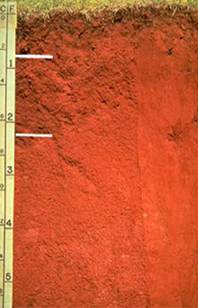 |
| Fig.1 Ferralsol Hawai |
| (
Source: www.colorado.edu/.../geog_1011_f02/
study2_02.html) |
|
-
Ferralsols are the classical deeply weathered red or
yellow soils of the humid tropics. They are dominated by low activity clays
(LAC), mainly kaolinite and sesquioxides.
-
International names are, for example:
-
Latosols (Brazil)
-
Oxisols (Soil Taxonomy, USA)
-
Sols ferralitiques (France)
-
Lateritic soils (Russia)
|
Parent material and environment
Parent material:
-
Strongly weathered material on old, stable geomorphic
surfaces. Ferralsols are more prevalent in weathering material from basic rock
than in acid silicious material.
Environment:
-
Ferralsols occur in a wide variety of landscapes. Large
contiguous areas of Ferralsols are found on old geomorphic surfaces, such as
the Congo Basin and the Amazon Shield. These surfaces are peneplained and are
comprised of mid-to end-Tertiary deposits, some of them pre-weathered.
Ferralsols have developed on such deposits. In general these old peneplains are
flat but some have been dissected. They are less common on younger, easily
weathering rocks. In SE Asia and Oceania, where the landscapes are Quaternary,
Ferralsols are formed on basic or ultrabasic rocks which are highly weatherable
(see Beinroth et al., 1996; World Soil Resources Report 94, 2001).
-
Some ferralsol landscapes are shown here:
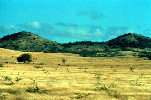 |
| Fig.2 Ferralsol landscape on stable plateau in the
semi-arid SW of Puerto Rico |
| (
Source: Beinroth et al., 1996.) |
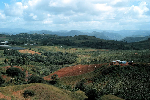 |
| Fig.3 Puerto Rico: Ferralsols occupy the flat
landforms |
| (
Source: Beinroth et al., 1996.) |
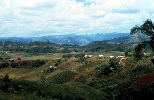 |
| Fig.4 Puerto Rico: Ferralsols occupy the flat
landforms. Alisols on the slopes |
| (
Source: Beinroth et al., 1996.) |
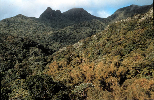 |
| Fig.5 Ferralsols also occur in a dissected
landscapes. Here under rainforest in NE Puerto Rico. |
| (
Source: Beinroth et al., 1996.) |
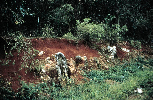 |
| Fig.6 Some Ferralsols are shallow because they
developed on weathering products of limestone. It is highly probable that the
soil material is a mixture of direct weathering products and transported
infilling of a microkarst landscape. Here: in Puerto Rico |
| (
Source: Beinroth et al., 1996.) |
 |
| Fig.7 Ferralsols at high elevations (> 1000 m) in
the tropics have a humus-rich surface horizon. There is more than 16 kg of
organic carbon to a depth of 1 m over an area of 1 m2. These soils are better
suited for low input agriculture than those of the lowland tropics which
contain less organic matter. Here: humic Ferralsol from Rwanda. Bananas are
intercropped with maize; peanuts are in the foreground. |
| (
Source: Beinroth et al., 1996.) |
Regional Distribution
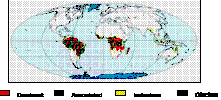 |
| Fig.8 World Soil Map (Ferralsol) |
| (
Source: FAO, 2001.) |
-
The only map available for an assessment of the global extent
and geographic distribution is the Soil map of the World (FAO-UNESCO,
1971-1976) which has been digitized by FAO.
-
The worldwide extent of Ferralsols is estimated at some 750
Mio. ha, almost exclusively in the humid tropics on the continental shields of
South America (Brazil) and Africa (Zaire, southern Central African republic,
Angola, Guinea and eastern Madagascar.
-
Outside of the continental shields, in SE Asia and the
Pacific Islands, ferralsols are restricted to regions with easily weatherable
basic parent material and a humid-moist climate.
Definition
 |
| Fig.9 Ferralsol Hawai [Bo1 and Bo2 = oxic (ferralic B)
horizon] |
| (
Source: www.colorado.edu/.../geog_1011_f02/ study2_02.html) |
-
Must have a ferralic B horizon between 25 to 200 cm
depth.
-
Lacking a
 nitic
horizon within 100 cm from the soil
surface. nitic
horizon within 100 cm from the soil
surface.
-
Lacking an argic horizon that has 10 % or more
water-dispersible clay within 30 cm of its upper boundary (unless contains more
than 1.4 % C).
-
Cation exchange capacity
(
 CEC)
< 16 cmolc/kg
clay (1 M NH4OAc solution buffered to pH 7), see
( CEC)
< 16 cmolc/kg
clay (1 M NH4OAc solution buffered to pH 7), see
( exchange
capacity)
. exchange
capacity)
.
-
Has less than 10 % weatherable minerals in the silt
fraction.
-
Has less than 5 % volume of the soil which has rock
structure.
-
Lack of clear horizon boundaries. The profile appears to be
very uniform from the surface to the parent material.
Genesis
-
Ferralitization (Desilication) is hydrolysis in an advanced
stage. If the soil temperature is high and percolation intense (humid climate)
all weatherable primary minerals will ultimately dissolve and be removed from
the soil mass. Less soluble compounds such as iron and aluminum oxides and
hydroxides
(
 Sesquioxides)
and coarse quartz grains
remain behind
( Sesquioxides)
and coarse quartz grains
remain behind
( process of
ferralitization)
. process of
ferralitization)
.
-
The process of ferralitization is furthered by the following
conditions:
-
Low soil-pH and low concentrations of dissolved weathering
products in the soil solution promote desilication and build-up of high levels
of (residual) Fe and Al.
-
Geo-morphological stability over long period of time is
essential. Ferralitization is a slow process (also in the humid
tropics).
-
Basic parent material contains relatively much Fe and Al in
easily weatherable minerals, and little silica. Ferralitization proceeds much
slower in acidic material that contains more quartz.
-
The Si-content in the soil solution remains higher than in
soils in basic material; this Si combines with Al to the 1:1 clay mineral
kaolinite (kaolinitization), particularly where internal drainage is impeded
(see fig.5 below).
 |
| Fig.10 Gibbsite and kaolinite formation under
various drainage conditions |
| (
Source: FAO, 2001.) |
Characteristics of Ferralsols
Morphological
characteristics
-
Ferralsols show a range of colors and other special features.
Those in cold highland areas generally have an organic rich surface horizon.
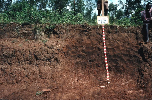 |
| Fig.11 humic Ferralsol from Rwanda |
| (
Source: ISRIC, Nl.) |
The lowland Ferralsols have a thin, light colored, organic
surface horizon.
-
Many Ferralsols have
(
 stone-lines)
with the stones being quartz
or petroplinthite gravel. Petroplinthite is also referred to as hard laterite. stone-lines)
with the stones being quartz
or petroplinthite gravel. Petroplinthite is also referred to as hard laterite.
 |
| Fig.12 plinthic Ferralsols with stoneline,
Thailand |
| (
Source: ISRIC, NL.) |
-
The color of the Ferralsol is generally a function of the
iron content in the original material or rock. The color is also related to the
kind of Fe minerals with goethite producing yellow colors
 |
| Fig.13 xanthic Ferralsols, Rwanda |
| (
Source: ISRIC, NL.) |
and hematite, red colors (see fig.1).
-
Ferrihydrite [Fe (OH)3] is a common
weathering product of Fe-rich parent material.
 Hematite
(Fe2O3) develops from
ferrihydrite and gives mayn tropical soils their bright red color Hematite
(Fe2O3) develops from
ferrihydrite and gives mayn tropical soils their bright red color
 rubefaction if: rubefaction if:
-
Fe-concentration is high
-
 SOM is low (Fe-Humus-complexes
inactivate Fe) SOM is low (Fe-Humus-complexes
inactivate Fe)
-
Temperature is high (accelerates de-hydration of Ferrihydrite
and decomposition of SOM)
-
pH > 4.0 (otherwise Fe (OH)2+
Monomeres are formed)
-
Goethite (FeOOH) develops when one or more of the conditions
are not reached.
 Goethite
has a yellow-orange color (dominance of poorly crystallized Fe-hydroxides). Goethite
has a yellow-orange color (dominance of poorly crystallized Fe-hydroxides).
 |
| Fig.14 Soil profile containing
goethite |
|
 |
| Fig.15 “Yellowisation process”, i.e. the formation
of goethite |
| (
Source: www.soilmaps.it/soilphotos/ page_02.htm) |
Physical characteristics
-
The texture may vary from a sandy loam to a clay. Many
Ferralsols have stable micro-aggregates which explain the excellent porosity
and good permeability and favorable infiltration rates. The stable soil
structure is based on the bonding between negatively charged LAC (kaolinite)
and positively charged Fe/Al-oxides and is sometimes termed
pseudo-sand-structure. Despite high clay contents, finger exercise (=a ped is
gently pressed between the thumb and fore-finger) gives a loamy-sandy
texture.
-
Ferralsols with low contents of Fe and/or organic matter
(e.g. xanthic Ferralsols in Surinam and Brazil) have less stable structure
elements, especially the sandy ones. Surface sealing and compaction become
serious limitations if such soils are taken into cultivation.
Chemical characteristics
-
Ferralsols are chemically poor soils, and generally have low
nutrient contents and low CEC due to the prevalence of variable-charged
kaolinites and Fe/Al-oxides
(
 exchange capacity)
. exchange capacity)
.
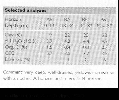 |
| Fig.16 Nutrient concentrations of a xanthic Ferralsol,
Zaire |
| (
Source: Bridges, 1997.) |
-
In deeper subsoil, nitrate may accumulate due to
anion-sorption by positively charged Fe/Al-oxides (see chapter "Anion exchange
capacity" in
(
 exchange
capacity)
.) exchange
capacity)
.)
-
Protonation of hydroxylic groups at low pH-values may boost
the soil’s AEC to the extent that the AEC equals the CEC, and is termed
(
 point of zero net
charge)
. point of zero net
charge)
.
-
This can be detected by determining the
 delta
pH of the soil. delta
pH of the soil.
Management and Use
-
Most ferralsols have good physical properties but the
chemical fertility is poor to very poor.
-
Under natural vegetation the nutrient cycling is very tight
between the above-ground vegetation and the surface soil layer. The bulk of all
cycling plant nutrients is contained in the plant biomass. Nutrient elements
that are taken up by the roots are eventually returned to the surface soil with
falling leaves and other plant debris. If this tight nutrient cycling is
interrupted, e.g. after forest clearing for agricultural production, the root
zone of the surface soil layer will rapidly become depleted of plant
nutrients.
-
As the natural nutrient retention capacity of kaolinites and
sesquioxides is very low, soil organic matter (SOM) plays a crucial role to
sustain CEC, N and P supply through SOM mineralization, to improve the water
holding capacity, and counteract the AEC of Fe/Al-oxides (P-fixation). Hence,
the management of ferralsols is the management of SOM.
-
Management practices like mulching and manuring, the
introduction of perennial crops (e.g. plantations), cover crops and enrichment
fallows (=N fixing trees are incorprated in fallow period) are important
practices to maintain SOM and soil fertility, and prevent surface soil erosion.
Otherwise the productivity and fertility of the soils declines rapidly
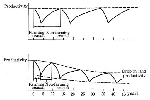 |
| Fig.17 Productivity decline of soils under shifting
cultivation |
| (
Source: www.env.go.jp/en/w-paper/
1990/eae190000000000.htm) |
-
Management practices are:
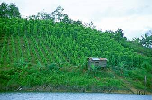 |
| Fig.18 Black pepper plantation; Brazil |
| (
Source: ISRIC, NL.) |
 |
| Fig.19 Mixed cropping, E-Java,
Indonesien |
| (
Source: ISRIC, NL.) |
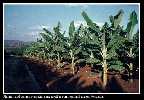 |
| Fig.20 Plantain and banana plantation are another
common land use on Ferralsols |
| (
Source: ISRIC, NL.) |
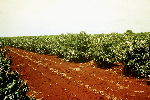 |
| Fig.21 Maize was planted as inter-row crop with
coffee, Brazil. After harvest, the stubble has been plowed, leaving the soil
surface susceptible to erosion. |
| (
Source: Beinroth et al., 1996.) |
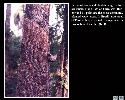 |
| Fig.22 Rubber is a commonly planted estate crop on Ferralsols. |
| (
Source: ISRIC, NL.) |
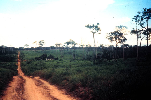 |
| Fig.23 Brazil: forest clearing and establishment of
pasture sites |
|
 |
| Fig.24 Gully erosion from the savanna region near
Brasilia, Brazil as a result of land clearing and establishment of
pasture |
| (
Source: Beinroth et al., 1996.) |
 |
| Fig.25 Iguassu Falls at the border of Argentina and
Brazil: the water is red due to very high sediment loading from land clearing
activities in Brazil’s north |
| (
Source: Beinroth et al., 1996.) |
-
Without maintaining adequate fallow periods for soil nutrient
restoration (after 2-4 years of cropping) and sustaining soil organic matter
and nutrient in the system, the fertility and productivity of ferralsols
declines rapidly.
-
Strong retention of phosphorous (P-fixation) is a problem of
many Ferralsols.
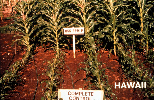 |
| Fig.26 Phosporus response of maize crops planted on
Ferralsols, Hawaii |
| (
Source: Beinroth et al., 1996.) |
-
P was applied in small amounts and periodically to counteract
leaching losses and fixation. In the absence of P, as in the foreground, the
maize does not grow (see fig.20).
-
The ferralic B horizon reacts with P-Ions:
-
Chemically bind them on Fe7Al surfaces
of the clay, i.e. positively charged oxides react with negatively charged
PO43- ions
(
 exchange
capacity)
. exchange
capacity)
.
-
May form independent Fe (FePO4) or Al
(AlPO4) precipitates.
|

 previous | next
previous | next

 previous | next
previous | next